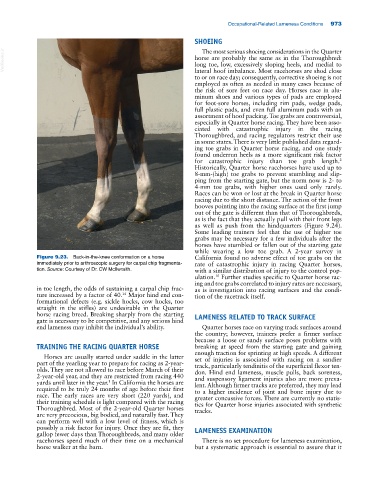Page 1007 - Adams and Stashak's Lameness in Horses, 7th Edition
P. 1007
Occupational‐Related Lameness Conditions 973
SHOEING
VetBooks.ir horse are probably the same as in the Thoroughbred:
The most serious shoeing considerations in the Quarter
long toe, low, excessively sloping heels, and medial to
lateral hoof imbalance. Most racehorses are shod close
to or on race day; consequently, corrective shoeing is not
employed as often as needed in many cases because of
the risk of sore feet on race day. Horses race in alu
minum shoes and various types of pads are employed
for foot‐sore horses, including rim pads, wedge pads,
full plastic pads, and even full aluminum pads with an
assortment of hoof packing. Toe grabs are controversial,
especially in Quarter horse racing. They have been asso
ciated with catastrophic injury in the racing
Thoroughbred, and racing regulators restrict their use
in some states. There is very little published data regard
ing toe grabs in Quarter horse racing, and one study
found underrun heels as a more significant risk factor
for catastrophic injury than toe grab length.
2
Historically, Quarter horse racehorses have used up to
8‐mm‐(high) toe grabs to prevent stumbling and slip
ping from the starting gate, but the norm now is 2‐ to
4‐mm toe grabs, with higher ones used only rarely.
Races can be won or lost at the break in Quarter horse
racing due to the short distance. The action of the front
hooves pointing into the racing surface at the first jump
out of the gate is different than that of Thoroughbreds,
as is the fact that they actually pull with their front legs
as well as push from the hindquarters (Figure 9.24).
Some leading trainers feel that the use of higher toe
grabs may be necessary for a few individuals after the
horses have stumbled or fallen out of the starting gate
while wearing a low toe grab. A 2‐year survey in
Figure 9.23. Back‐in‐the‐knee conformation on a horse California found no adverse effect of toe grabs on the
immediately prior to arthroscopic surgery for carpal chip fragmenta- rate of catastrophic injury in racing Quarter horses,
tion. Source: Courtesy of Dr. CW McIlwraith. with a similar distribution of injury to the control pop
ulation. Further studies specific to Quarter horse rac
10
ing and toe grabs correlated to injury rates are necessary,
in toe length, the odds of sustaining a carpal chip frac as is investigation into racing surfaces and the condi
ture increased by a factor of 40. Major hind end con tion of the racetrack itself.
14
formational defects (e.g. sickle hocks, cow hocks, too
straight in the stifles) are undesirable in the Quarter
horse racing breed. Breaking sharply from the starting LAMENESS RELATED TO TRACK SURFACE
gate is necessary to be competitive, and any serious hind
end lameness may inhibit the individual’s ability. Quarter horses race on varying track surfaces around
the country; however, trainers prefer a firmer surface
because a loose or sandy surface poses problems with
TRAINING THE RACING QUARTER HORSE breaking at speed from the starting gate and gaining
Horses are usually started under saddle in the latter enough traction for sprinting at high speeds. A different
set of injuries is associated with racing on a sandier
part of the yearling year to prepare for racing as 2‐year‐ track, particularly tendinitis of the superficial flexor ten
olds. They are not allowed to race before March of their don. Hind end lameness, muscle pulls, back soreness,
2‐year‐old year, and they are restricted from racing 440 and suspensory ligament injuries also are more preva
yards until later in the year. In California the horses are lent. Although firmer tracks are preferred, they may lead
1
required to be truly 24 months of age before their first to a higher incidence of joint and bone injury due to
race. The early races are very short (220 yards), and greater concussive forces. There are currently no statis
their training schedule is light compared with the racing tics for Quarter horse injuries associated with synthetic
Thoroughbred. Most of the 2‐year‐old Quarter horses tracks.
are very precocious, big bodied, and naturally fast. They
can perform well with a low level of fitness, which is
possibly a risk factor for injury. Once they are fit, they LAMENESS EXAMINATION
gallop fewer days than Thoroughbreds, and many older
racehorses spend much of their time on a mechanical There is no set procedure for lameness examination,
horse walker at the barn. but a systematic approach is essential to assure that it

